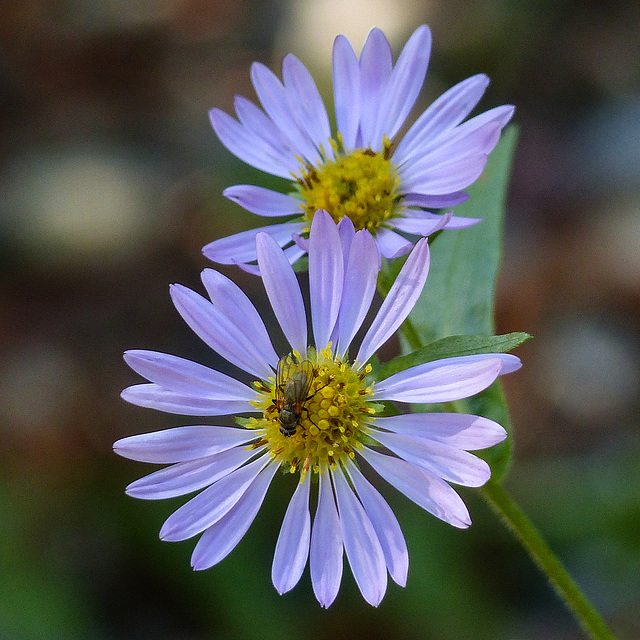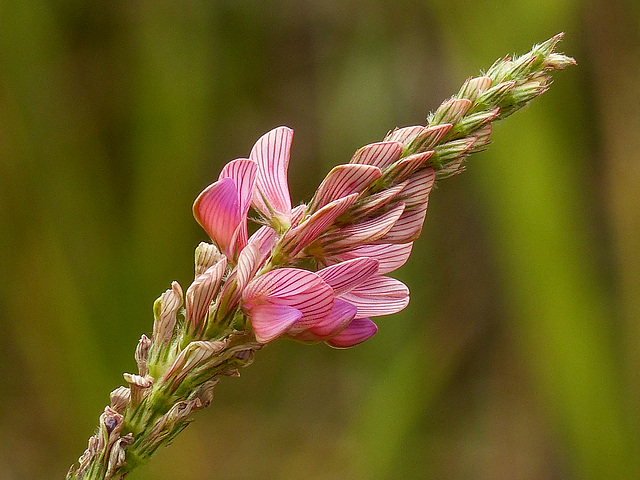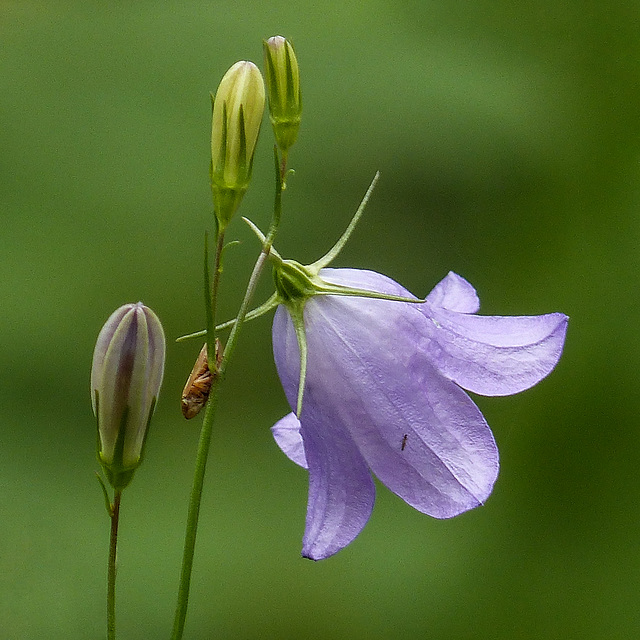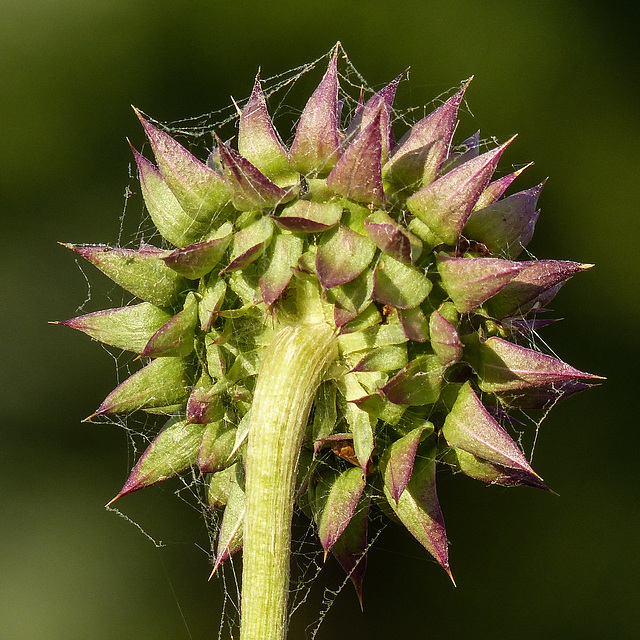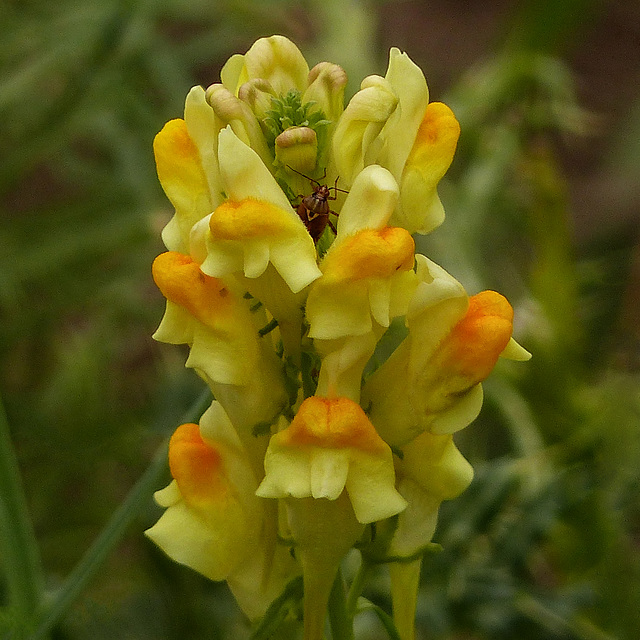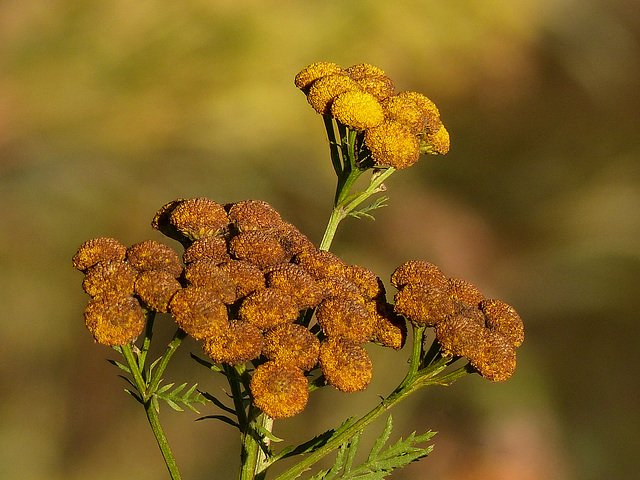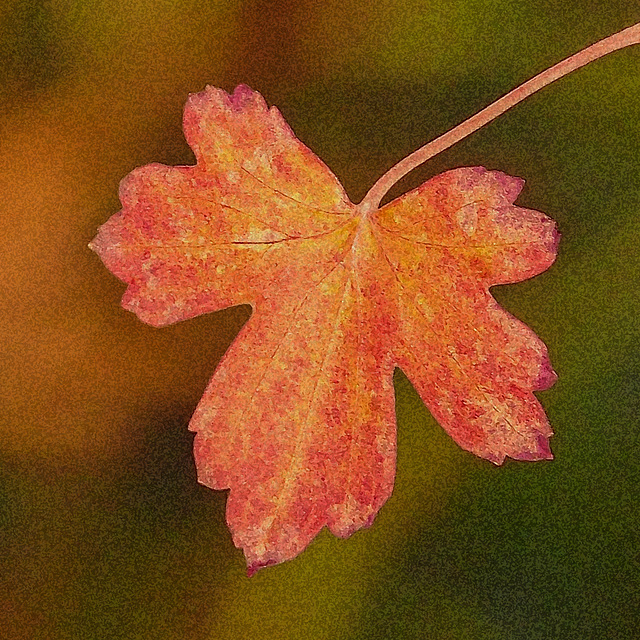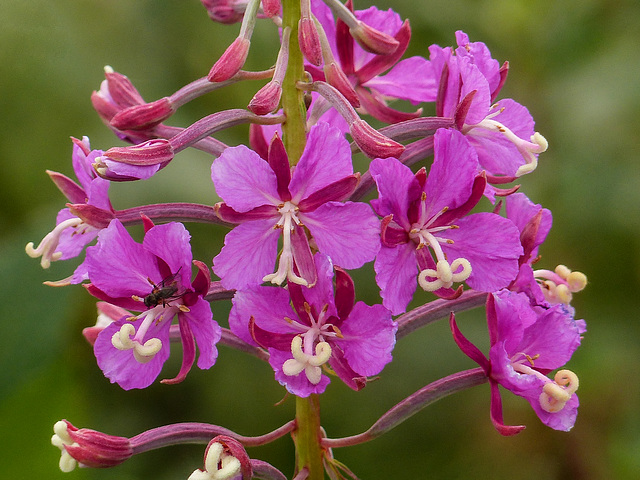
Plants of Alberta 6
26 Aug 2014
Asters plus fly
At this time of year, there are Asters growing in the wild everywhere, When I see them, I know that fall is on its way. Today, 3 September 2014, at 9:30 a.m., it is pouring with rain and the temperature is 8C (apparently feels like 4C).
This photo was taken along the Akamina Parkway in Waterton Lakes National Park, on 26 August 2014. Friends, Cathy and Terry, and I, stayed for two nights in Waterton, on 26 and 27 August 2014. This park is about 276 km south of Calgary and roughly a three hour drive. During the time we were there, we explored all four drives in the area: the Akamina Pathway that leads to Cameron Lake; the Red Rock Parkway; the Chief Mountain Highway which takes you up to the US/Canada Customs; and the Bison Paddocks. This was a driving trip, not a hiking trip - which is just as well, as a young woman was attacked by a Cougar on one of the trails, on one of the days!
A few of the things we saw during our three-day trip included fantastic scenery, 4 Black Bears (including one that was swimming in the lake), Bison, Deer (including several that we saw in the village of Waterton, where we stayed the two nights at the clean and friendly Bear Mountain Motel), Golden-mantled Ground Squirrels, Chipmunks, various bird species including the endangered Burrowing Owls (new to all three of us), a few wildflowers, several Yellow-bellied Marmots (a first for me!), a few different insect species, and a family of some species of Grouse (still not sure what kind). I even got the chance to see three or four new-to-me old, wooden grain elevators.
02 Sep 2014
Sainfoin / Onobrychis viciifolia
Sainfoin has been grown in parts of Europe and Asia for hundreds of years. Various strains have been introduced to North America as a forage crop since about 1900. I came across this plant growing at Carburn Park on 2 September 2014, when I was on a birding walk - I think this is the only location in the city where it grows. Belongs to the Pea family and blooms June-August. It is considered a weed, but, as usual, a very beautiful weed. I love the deep pink stripes on the petals.
"Like many plants with a long period of human use, it is known by many common names. In English, it is commonly called sainfoin from the French for "healthy hay". Sometimes it is called holy hay--a confusion of "saint" for "sain".
Healthy hay is a fitting moniker. It is nutritionally comparable to alfalfa and equally, if not more, palatable to livestock. In addition, research has shown that it inhibits nematode parasitism in ruminants due to its high tannin content. A good report on the use of sainfoin as a feed crop is available on Feedipedia: Onobrychis viciifolia, while images of the species growing as a field crop are available via the Alberta Native Plant Council. As a crop, the plant is considered a good environmental choice: it forms a deep tap root that helps soil stabilization, its roots house nitrogen-fixing bacteria that improve the soil, and its melliferous flowers attract bees and birds. A fine, clear honey has been produced in areas where the plant is cultivated. Lastly, it is more tolerant of drought and cold than other forage crops like alfalfa and clover.
Despite its many benefits, it has largely been replaced by alfalfa and clover in the past century. The main drawback is its poor regrowth after cutting and resultant lower production." From UBC Botany Photo of the Day website.
www.botanicalgarden.ubc.ca/potd/2013/04/onobrychis-viciif...
20 Jul 2014
Harebell and tiny visitors
This delicate Harebell, complete with two tiny visitors, is one of the few wildflower photos that I got round to taking this summer. It was taken on 20 July 2014, the day that I plucked up courage to do a drive that I’d never done before - to Bow Valley Provincial Park, at the foot of the eastern edge of the Rocky Mountains. I had been that route to the park once before that I can think of, when I carpooled with others. A good part of the drive was in familiar territory, but I’d never driven the last part of the journey myself. I had met my daughter at 9:00 a.m. and we were both eager to see a display of birds of prey that had been brought up from the Coaldale Birds of Prey Centre.
23 Jul 2014
The fancy web work of a spider
Perhaps I should whisper that this is my favourite Thistle, seeing as it is a weed : ) It is called Nodding Thistle, also Musk Thistle, and was introduced from Europe and North Africa. A member of the Aster family, it grows to 60-250 cm tall, with flower heads that are 1.5-8 cm across. This particular plant was growing on 23rd July 2014 at the Erlton/Roxboro Natural Area. It was past its prime, as the purple disc florets have died, but I am always fascinated with the spine-tipped, inner and outer bracts. This time that I went, the sun was in the wrong position to try and photograph the plants from the other side.
After a volunteer shift on that day, 23 July 2014, I wasn't too far away from the Erlton/Roxboro Natural Area, where I was finally going to go on a botany walk. Having been to this location several times before, I knew it was a short, easy, flat trail, and that I could go as far as I wanted and then turn back early, which is what I did. I've missed pretty well all the botany and birding walks the last few months, which is quite depressing. The main thing I wanted to see were these Nodding / Musk Thistles.
With a couple of hours to "kill" after my volunteer shift, I spent them at the Reader Rock Garden, which was just a few minutes' drive away from the evening botany walk at the Erlton/Roxboro Natural Area.
02 Sep 2014
Butter-&-eggs
Just an ordinary shot of this invasive weed, but I loved seeing the tiny bug (Tarnished Plant Bug?) hiding in its bright and cheery surroundings. I always enjoy seeing the heart-shaped marking on the "back" of these tiny, common insects. This photo was taken on 2 September 2014, when I was on a birding walk at Carburn Park. The parking lot at Carburn is closed to the public at the moment, while workers are constructing a "rain garden" or "water garden". It will be interesting to see what this is, when it's all finished.
Also known as Common Toadflax, this plant was introduced from Europe as a garden plant, but has now become an aggressive weed.
www.invasiveplants.ab.ca/Downloads/FS-CommonToadflax.pdf
14 Sep 2014
Fall colours of Common Tansy
Though Common Tansy (Tanacetum vulgare) is a weed that grows in our parks and natural areas, I still like coming across it, with its beautiful bright yellow, button-like flowers. This particular plant was photographed at Lafarge Meadows, Fish Creek Provincial Park, on 14 September 2014. In Alberta, this plant is listed as Noxious. It was a beautiful, sunny day - hard to believe that we had had two heavy, late-summer snowfalls on 9 and 10 September.
"Introduced from Europe in the 1600’s, its pungently aromatic foliage has been used medicinally, as an insect repellant, and for embalming. Common tansy forms dense stands and the plants contain alkaloids that are toxic to both humans and livestock if consumed in large quantities. Cases of livestock poisoning are rare, though, because tansy is unpalatable to grazing animals. Because of its long medicinal and horticultural use, Common tansy is still available in plant nurseries and from herbal remedy suppliers. Gardeners should not purchase Common tansy."
20 Sep 2014
1 favorite
1 comment
Fall colours
Just a very small leaf from a bush that was growing at the side of a path that I walked along, to go and see if there was any sign of the Beavers in Fish Creek Park, on 20 September 2014. Not sure if it's some kind of Currant. The leaves were such a beautiful orange colour. When I was editing this image late last night, I had a quick look to see if there was some way I could make the leaf stand out a little more. I happened to see "Sponge effect", clicked on it, and thought it was different and I quite liked it. Honestly, it's really not noise from a photo taken in very poor light, lol!
We need some strong colour today, as it's pouring with rain this morning. Rain that certainly wasn't mentioned in the weather forecast last night, ha. It is supposed to clear up this afternoon, though.
19 Aug 2014
Eye-catching Fireweed
Fireweed was nicely in bloom when I went with friends, Cathy and Terry, for a great day out in the mountains on 19 August 2014. Our trip was part way along Highway 40 and then along the Smith-Dorrien/Spray Lakes Trail. We passed maybe three or four large, dense patches of Fireweed that were absolutely beautiful. Wish I could say the same about the sky - it was far from blue. The weather forecast was not good for this day, but we were so lucky that, apart from a few raindrops, the rain stayed away. The sun actually came out at two locations we stopped at for a short while.
"Coming to a newly opened (Fireweed) flower, a bee finds abundant pollen on the anthers and a sip of nectar in the cup below. At this stage the flower keeps its still immature style curved downward and backward lest it should become self-fertilized - an evil ever to be guarded against by ambitious plants. In a few days, or after the pollen has been removed, up stretches the style, spreading its four receptive stigmas just where an in-coming bee, well dusted from a younger flower, must certainly leave some pollen on their sticky surfaces." From chestofbooks.com/flora-plants/flowers .
29 Sep 2014
1 favorite
Similar to a Dandelion
Saw these wildflowers on 29 September 2014, growing at the Hoodoos Trail near Drumheller, in the Badlands of Alberta. They reminded me of Dandelions and then of Sow Thistles, but the leaves just weren't right. I think Art (LeapFrog) has the right ID - Spiny-leaved Sow Thistle.
Jump to top
RSS feed- Latest items - Subscribe to the latest items added to this album
- ipernity © 2007-2024
- Help & Contact
|
Club news
|
About ipernity
|
History |
ipernity Club & Prices |
Guide of good conduct
Donate | Group guidelines | Privacy policy | Terms of use | Statutes | In memoria -
Facebook
Twitter

